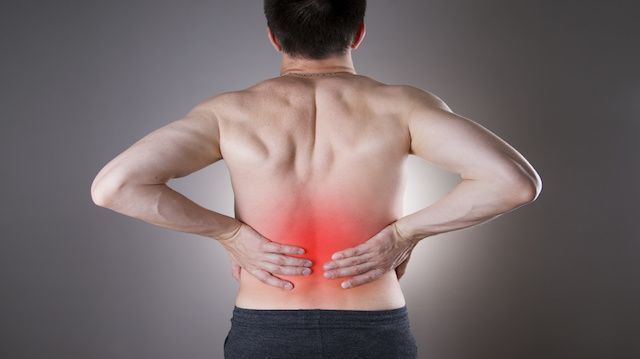
If you’ve never experienced back pain, you can consider yourself to be among the lucky few. According to the American Chiropractic Association, eight out of 10 people experience back pain at some point during their life, and it’s the second most common reason people cite for taking sick days. Many reasons for back pain, such as arthritis, disc pain and fibromyalgia, are well known. However, did you know that back pain can be related to much simpler issues like posture, diet and flexibility? Here are nine surprising factors that may be causing your back pain or making it worse.You have a weak core
Weak, tight core muscles are a common cause of lower back pain. Many studies have shown that strengthening the core, or the muscles in your abdomen and back, can reduce lower back pain and decrease the risk of future injury to that area. But before you start doing sit-ups, know that focusing on “six-pack” building exercises, like sit-ups and crunches, can actually make lower back pain worse. Instead, incorporate moves like plank, which target the deeper core muscles that aid stability and posture.
Your hip flexors and hamstrings are tight
Flexibility is not only important for mastering yoga poses, it’s also crucial for good posture and pain-free living. When your hamstrings and hip flexors are tight, it causes your pelvis to be pulled down and away from your lumbar spine, thus increasing instability and pain in the lower back. Stretches and yoga poses that keep your hamstrings and hip flexors loose and lithe are a great way to both prevent and combat back pain. These include forward bends (keeping your spine long) for your hamstrings, and gentle lunges for your hip flexors.
Your pelvis is out of alignment
Simple and small postural misalignments repeated over a lifetime can have a huge impact on the health of your back. Habits that tilt your pelvis toward one side, such as keeping your wallet in your back pocket, or tilt your pelvis backward, such as slumping and poor posture, can lead to issues like sciatica and lower back pain later down the road. Developing more body awareness along with strengthening the core, stretching the hamstrings and hip flexors, and practicing better posture can help realign the pelvis.
Your diet sucks
Okay, so maybe that’s a little harsh, but seriously, eating the Standard American Diet (SAD) is really not helping your back. Inflammation is at the root of most diseases and health conditions, and this includes back pain. Eating a whole-food diet full of antioxidants, healthy fats and anti-inflammatory spices can help to lessen pain, while eating the SAD diet can increase inflammation, and likely make it worse.
You sit all day
Sitting all day, especially with poor posture, can threaten the integrity of your entire spinal column. Hunching over a desk and craning to look at a computer can strain your vertebrae, leading to pain, soreness and degenerated discs.
You have poor posture
It should not be surprising to hear that posture contributes to back pain. Training yourself to sit and stand up straight, with your ears over your shoulders and your pelvis tilted slightly forward, can go a long way in both preventing and reducing back pain.
You don’t exercise
Exercise is often the last thing you want to do when your back aches, but studies show that exercise, especially moves that emphasize flexibility and strength, can help to reduce back pain. According to a 2016 review of existing studies, exercise is also the most effective way to prevent back pain as well.
You sleep on your stomach
Although there is not a lot of science behind sleeping position and back pain, if you wake up in the morning with back pain but felt fine the night before, your sleeping posture may be something you should examine. For a healthy and pain-free back, most physical therapists recommend sleeping on your back or on your side with a straight spine (not in the fetal position).
You’re depressed
Although it makes sense that chronic back pain can lead to depression, what you may not know is that depression can also lead to back pain. A review of existing studies revealed that 14 out of 16 studies found that depression put people at risk for developing backaches. The studies suggest that addressing mental and emotional health issues may be an important step in finding a solution to back pain.
To address the functional issues that may be causing your back pain or making it worse, it’s best to work with an experienced physical therapist who can address your individual needs, and teach you how to do exercises that are safe and effective for you. Practicing meditation is also a great way to reduce back pain caused by depression, and lower your risk of injury.
—Teresa Manring
Teresa is a freelance writer and yoga teacher currently living in Sri Lanka. She loves to write about policies, ideas, and practices that promote a healthy planet and create healthy people.
Sources:
http://www.ncbi.nlm.nih.gov/pubmed/10788861
http://www.ncbi.nlm.nih.gov/pmc/articles/PMC3011108
http://www.ncbi.nlm.nih.gov/pubmed/14749199
http://www.ncbi.nlm.nih.gov/pubmedhealth/behindtheheadlines/news/2016-01-13-exercise-is-most-effective-method-of-preventing-lower-back-pain
http://www.ncbi.nlm.nih.gov/pmc/articles/PMC3084409
http://www.ncbi.nlm.nih.gov/pubmed/25467999
http://www.ncbi.nlm.nih.gov/pmc/articles/PMC4395677
http://www.acatoday.org/Patients/Health-Wellness-Information/Back-Pain-Facts-and-Statistics

